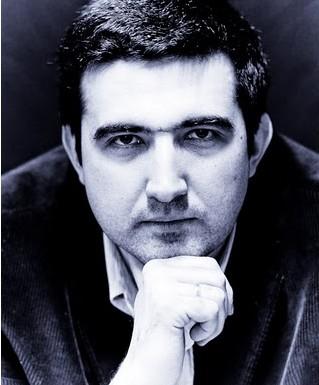
The Best Moves Never Played: Intuition (Part 4)
With the last few articles we studied Magnus Carlsen's comments after the games from the recent London Classic and analyzed the ones that had to do with intuitive approach towards the position. Today I would like to concentrate of some of the positions from Kramnik's play from the same tournament. Isolating moments that corresponded to intuitive assessment or judgement of the position was not that easy. Kramnik in his after-game commentaries tends to provide tons of ideas and specific lines; nevertheless there are few moments that fit today's topic.
In the following position, Kramnik gives a precise positional evaluation:

"The point of the position is I need to keep my rook. If black manages to exchange the rook then he has good drawing chances but if I keep my rook my bishop on d5 is very strong and I have two pawns, so slowly I will advance my pawns. That is why Ra5 is a good move." White bishops restrict two rooks but if black exchanged a pair of rooks then the remaining rook will have more space to move. Also, there is a higher chance to end up in R vs. B endgame, which should be favorable for black. Kramnik notices that the Bd5 is very strong: it can support both flanks and attack many squares in black's camp. With such a strong bishop it is just a matter of time until white wins by pushing the queenside pawns. This is why Kramnik thinks that Ra5 is necessary. Black cannot just sit and wait but has to come up with an active plan. Computer finds an alternative plan for black that might be even better than Ra5.
In the next critical moment Kramnik criticizes his decision as it gives black too much counterplay.
"g4 I should have played, you know in my pensioner style, not to allow any counterplay, just very slowly... f4 was a little bit hasty I would say. Because g4 I just stop f5 and then slowly h4-h5... It should be technically won". However, it seems that f4, played in the game is indeed the strongest move and Kramnik played it in the game, even if he felt that g4 was stronger.
Kramnik is very good at converting advantage - he has a perfect killing instinct and normally finishes his opponents in style and with extreme precision. Here, we see a moment where Kramnik comments on a practical decision he took during the game that might have not been objectively the strongest one, but from human perspective probably was.
"Here it is very easy. It is just about choosing the way of how to win. I decided to exchange the rooks...Ok it is maybe not the best way I am sure computer will show something better than this but it is the most human way because the king is cut and then I am slowly just pushing my pawn and there is nothing that black can do here."
The next game is extremely complex and I will pinpoint only two moments of interest. In the first moment Kramnik makes a move that gives white a small edge, however he could have chosen the move that led to an equal endgame. A miscalculation or misevaluation?

"I should have just probably taken on g5. I actually just confused the move order." After the exchanges on g5 and d2 Kramnik comments that: "After c5 it is probably just equal because the problem of d4-square. If the pawn was on c3 white could claim something but here always Nd4 coming." He also mentions that if white ever plays a4 the knight endgames would be a draw because after Nd4 the b3-pawn would be weak.
It is interesting how the players evaluate this position. "Black is quite ok here." Levon: "Actually, I thought I am much better here I thought your bishops are not right placed but then I played some inaccurate moves." Houdini agrees more with Aronian's evaluation, but Kramnik has vast experience playing these types of position and I am not sure if I trust computer evaluation of these endgames.
The game was highly eventful but let us skip to the very end where Kramnik could have still fought on.
"I think this is still a draw but maybe I could have played very very accurate move... But I felt it is just ridiculous if I manage to win two against two I couldn't really concentrate here, although I should have probably here at this moment. I still believe it is a draw but ok after Bf7 somehow I missed something..."
Here, Kramnik's feelings got on his way of finding the strongest move. Although the position is equal black can put more problems before white than what Kramnik did in the game. He felt it would be unfair to win the game in such a manner, what speaks of his value of aesthetics but this same idea can hurt one's results.
With next article we will wrap-up the series on Intuition.






